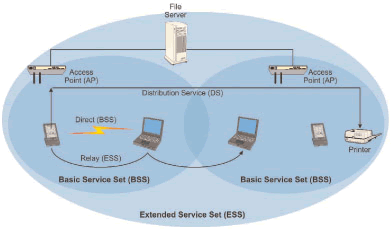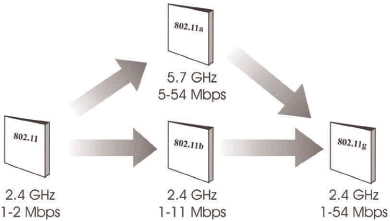| Introduction to Wireless Local Area Network (WLAN) |
| ALTHOS Mar 25,2006 Editor of CyberHome |
|
Overview
A Wireless Local Area Network (WLAN) is a wireless communication system that allows computers and workstations to communicate data with each other using radio waves as the transmission medium. The 802.11 industry standard and its various revisions are a particular form of Wireless LAN. 802.11 WLAN is commonly referred to as “Wi-Fi” (wireless fidelity). To help ensure Wi-Fi products perform correctly and are interoperable with each other, the Wi-Fi Alliance was created in 1999. The Wi-Fi Alliance is a non- profit organization that certifies products conform to the industry specification and interoperates with each other. Wi-Fi® is a registered trademark of the Wi-Fi Alliance and the indication that the product is Wi-Fi Certified™ indicates products have been tested and should be interoperable with other products regardless of who manufactured the product. Wireless LANs can be connected to a wired LAN as an extension to the system or it can be operated independently to provide the data connections between all the computers within a temporary (“ad-hoc”) network. WLANs can be used in both indoor and outdoor environments. Wireless LANs can provide almost all the functionality and high data-trans- mission rates offered by wired LANs, but without the physical constraints of the wire itself. Wireless LAN configurations range from temporary independent connections between two computers to managed data communication networks that interconnect to other data networks (such as the Internet). Data rates for WLAN systems typically vary from 1 Mbps to more than 50 Mbps. Wireless LAN systems may be used to provide service to visiting users in specific areas (called “hot spots”). Hot spots are geographic regions or service access points that have a higher than average amount of usage. Examples of hot spots include wireless LAN (WLAN) access points in coffee shops, airports, and hotels. Figure_WALN_1 shows a typical parts of a WLAN system. This diagram shows that 802.11 systems are used to communicate between mobile and stationary devices such as PDAs, laptops, and printers. WLAN systems are commonly connected to wire LAN systems and this allows wireless devices to access information and files on a company's file server or connecting to the Internet. This example shows that devices can communicate directly with each other (“ad-hoc”) or they can use distributed services through access points using local distributed services set (DSS) or wide area extended services set (ESS).
Figure_WALN_1: 802.11 Wireless LAN Systems There are several different versions of 802.11 WLAN systems that have evolved over time and some (not all) of these versions are compatible with other versions of 802.11 wireless LAN. The key differences include frequency band, type of wireless access, and maximum data transmission rates. Figure_WALN_2 shows how 802.11 LAN systems have evolved over time. This diagram shows that the original 802.11 specification offered 1 or 2 Mbps data transmission rates and operated at 2.4 GHz. This standard evolved through new modulation to produce 802.11b that provides operated at 2.4 GHz and provided data transmission rates up to 11 Mbps. This diagram also shows that a new 802.11a system was developed that provides data transmission rates up to 54 Mbps at 5.7 GHz. To help provide high-speed data transmission rates and provide backward compatibility to 802.11 and 802.11b systems, the 802.11g systems was developed that offers 54 Mbps data transmission in the 2.4 GHz range.
Figure_WALN_2: Wireless LAN Evolution
|
| 【Print】 【Mailto】 |

